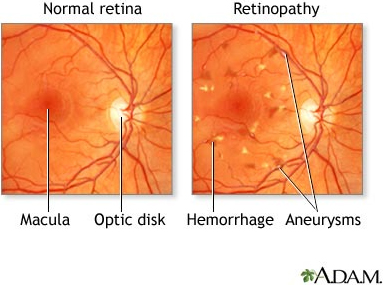Diabetic Eye Care
Ensuring good vision for a lifetime.
Diabetic Retinopathy
High blood-sugar levels from diabetes can damage blood vessels in your retina, the layer of nerve tissue at the back of your eye. This damage is called diabetic retinopathy. Early diagnosis and treatment can prevent vision loss, and it’s important to maintain control of your blood sugar if you have diabetes.

Symptoms & Diagnosis
Often there are no symptoms in the early stages of diabetic retinopathy so don’t wait for symptoms to have a comprehensive eye exam.
- Specks or spots floating in your vision – this may indicate proliferative diabetic retinopathy, the growth of abnormal new blood vessels on your retina and optic nerve.
- Blurred vision may occur when the macula – the small area at the center of the retina – swells from fluid leaking from retinal blood vessels. Rapid changes in blood sugar can cause temporary blurring of vision in both eyes even if retinopathy is not present.
- Pain or pressure in the eyes with uncontrolled diabetes
You should have your eyes checked promptly if you experience changes in your vision that last more than a few days and are not associated with a change in blood sugar.
A medical eye examination is the best way to detect changes inside your eye. An ophthalmologist, Eye M.D., can often diagnose and treat serious retinopathy before you are aware of any vision problems. The doctor dilates your pupil and looks inside the eye with special instruments and may take scans or pictures to look for diabetic eye problems.
Treatment
Treatment of diabetic eye disease has evolved significantly over time. Options for treatment now include eye injections of medications (Anti-VEGF inhibitors and Steroids) and laser treatments to both the macula and peripheral retina. These treatments require regular follow-up to ensure an appropriate response to treatment and improved vision.
Reducing your risk
People with diabetes should schedule examinations at least once a year. More frequent medical exams may be necessary after a diagnosis of diabetic retinopathy.
To reduce your risk or manage the disease, everyone with type 2 diabetes must be seen at least yearly by an ophthalmologist, Eye M.D., from the time of diabetes diagnosis. If you have been diagnosed with type 1 diabetes, you should see an ophthalmologist yearly beginning five years after the time of diabetes diagnosis. Pregnant women with diabetes should schedule an appointment in the first trimester, because retinopathy can progress quickly during pregnancy
Maintaining strict control of your blood sugar, blood pressure, blood cholesterol and following a strict diet are essential to preventing diabetic retinopathy in patients with diabetes.
Regular medical eye exams can help prevent unnecessary vision loss.
